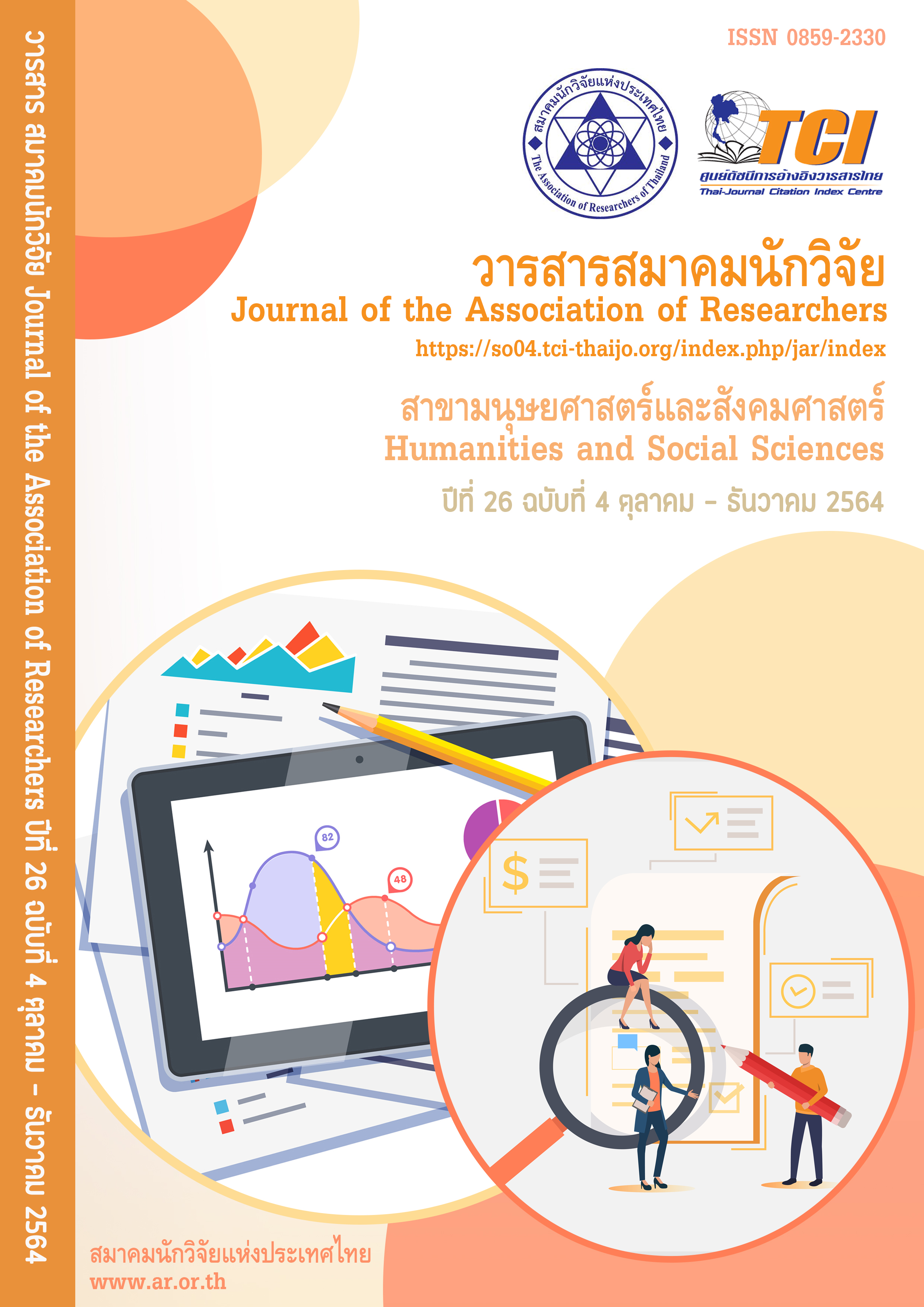Development of a solid waste management model in the community through environmental studies
Main Article Content
Abstract
Agriculture is the main occupation of the Sukhirin sub-district community, Sukhirin district, Narathiwat province. Consequently, there is a large amount of agricultural waste and solid waste, which causes environmental problems for air, water, soil, and sanitation of people in the community. Therefore, it is imperative to have proper waste management. The purpose of this research was to analyze the relationship between Types, occupations, and amount of waste generated in the community by using the Chi-square test and studying the appropriate format of the media for the community's solid waste management through the environmental education process. The study was conducted in the community area of the Sukhirin sub-district with 100 people using a convenient sampling method. The results of the study showed that agriculture significantly correlated with solid waste was an organic waste with the occupation of agriculture 85% generated organic waste 47% was agriculture. From the study of guidelines for organic waste management through environmental processes, it was found that the appropriate approach for management was to develop agricultural waste to develop into bio-fertilizer, compost from food waste, and pellet fertilizers. The broadcast in brochure format is 80% most appropriate when compared to the poster and video media. The brochures were able to convey knowledge in a concise and easy-to-understand manner at a high level (mean 4.01), which enabled the community to have a 50% better knowledge of solid waste management. In addition, it was found that all three forms of knowledge-based media contribute to participation in applying the knowledge gained in daily life until the knowledge gained can be transferred to another person
Article Details
บทความที่ปรากฏในวารสารนี้ เป็นความรับผิดชอบของผู้เขียน ซึ่งสมาคมนักวิจัยไม่จำเป็นต้องเห็นด้วยเสมอไป การนำเสนอผลงานวิจัยและบทความในวารสารนี้ไปเผยแพร่สามารถกระทำได้ โดยระบุแหล่งอ้างอิงจาก "วารสารสมาคมนักวิจัย"
References
กาญจนา แก้วเทพ. (2548). ก้าวต่อไปของการสื่อสารเพื่อการพัฒนาชุมชน. กรุงเทพฯ: สำนักงานกองทุน
สนับสนุนการวิจัย.
การทดสอบไคสแควร์. (ม.ป.ป.). สืบค้นจาก http://home.dsd.go.th/kamphaengphet/km/information/
RESECARCH/12Chi-Square_Test.pdf
เขมณัฏฐ์ มิ่งศิริธรรม. (2559). การออกแบบสื่อการศึกษา. กรุงเทพฯ: สำนักพิมพ์แห่งจุฬาลงกรณ์มหาวิทยาลัย.
ชยาภรณ์ ชื่นรุ่งโรจน์. (2548). การวางแผนการพัฒนาการท่องเที่ยว. เชียงใหม่: มหาวิทยาลัยเชียงใหม่.
ชูศักดิ์ วิทยาภัค. (2561). นิเวศวิทยามนุษย์ : การศึกษาสิ่งแวดล้อมในมิติของสังคมและวัฒนธรรม. เชียงใหม่:
ศูนย์บริหารงานวิจัย มหาวิทยาลัยเชียงใหม่.
ฐากร สิทธิโชค. (2559). การจัดกระบวนการเรียนรู้สิ่งแวดล้อมศึกษาในสถานศึกษา. วารสาร
มนุษยศาสตร์สังคมศาสตร์ มหาวิทยาลัยทักษิณ, 11(2559), 177-197.
ณัฐวดี สุขช่วย. (2558). พฤติกรรมการจัดการขยะมูลฝอยของประชาชนในเขตเทศบาลตำบลบ้านด่าน
อำเภออรัญประเทศ จังหวัดสระแก้ว. งานนิพนธ์รัฐศาสตรมหาบัณฑิต มหาวิทยาลัยบูรพา.
นุชนารถ รัตนสุวงศ์ชัย. (2562). จิตวิทยาการบริการ. กรุงเทพฯ: สำนักพิมพ์จุฬาลงกรณ์
มหาวิทยาลัย.
ปรเมษฐ ห่วงมิตร. (2557). พฤติกรรมการจัดการขยะมูลฝอยของประชาชนในเขตลาดพร้าว
กรุงเทพมหานคร. ปัญหาพิเศษนี้รัฐประศาสนศาสตรมหาบัณฑิต มหาวิทยาลัยบูรพา.
ปริวรรต สมนึก. (2558). การพัฒนานวัตกรรมการเรียนการสอนโดยใช้สื่อวีดิทัศน์ เพื่อเพิ่มผลสัมฤทธิ์ทางการเรียน
เรื่อง “ผลิตภัณฑ์การท่องเที่ยว”. วารสารวิชาการการท่องเที่ยวไทยนานาชาติ, 11(1), 4-17.
ไพบูลย์ แจ่มพงษ์. (2560). การจัดการขยะมูลฝอย. กรุงเทพฯ: สำนักพิมพ์แห่งจุฬาลงกรณ์มหาวิทยาลัย.
มัทนา เจริญวงศ์. (2562). พลเมืองสร้างสื่อ สื่อสร้างพลเมือง. นนทบุรี: ภาพพิมพ์.
ลัดดาวัลย์ กัณหสุวรรณ. (2561). 40 กิจกรรมกับสิ่งแวดล้อมศึกษา แนวทางการจัดกิจกรรมสิ่งแวดล้อม
สำหรับ ระดับประถม-มัธยมต้น. กรุงเทพฯ: นานมีบุ๊ค.
ลาวัณย์ วิจารณ์. (2559). สิ่งแวดล้อมศึกษา : แนวทางสู่การปฏิบัติ. ปทุมธานี: มหาวิทยาลัยรังสิต.
วริฏฐา หิมทอง. (2561). สื่อสาร สื่อสร้างสรรค์ สื่อใต้สันติสุข. กรุงเทพฯ: กรมประชาสัมพันธ์.
วินัย วีระวัฒนานนท์. (2562). หลักการสอนสิ่งแวดล้อม. กรุงเทพฯ: สมาคมสิ่งแวดล้อมศึกษาแห่งประเทศไทย.
วีรวัลย์ แก้วบุญชู. (2562). ปัจจัยที่ส่งผลต่อพฤติกรรมการคัดแยกขยะมูลฝอยในครัวเรือน
กรณีศึกษา เขตดอนเมือง กรุงเทพมหานคร. วิทยานิพนธ์ศิลปศาสตรมหาบัณฑิต มหาวิทยาลัยมหิดล.
สันธนี แผนดี. (2559). การพัฒนาทักษะการใช้ภาษาอังกฤษเพื่อการสื่อสารสำหรับประชาชนในชุมชนและ
ท้องถิ่นจังหวัดสมุทรปราการ. รายงานการวิจัย มหาวิทยาลัยราชภัฏธนบุรี.
สิรินทร์ ลัดดากลม บุญเชิดชู และมุจลินท์ กลิ่นหวล. (2559). กิจกรรมทัศนศึกษาเพื่อส่งเสริม
สมรรถนะการเรียนรู้ของเด็กปฐมวัยในศตวรรษที่ 21. Veridian E-Journal, Silpakorn
University, 9(3), 1550-1562.
อานัฐ ตันโช. (2559). คู่มือเกษตรอินทรีย์มหาวิทยาลัยแม่โจ้. เชียงใหม่: กองแผนงาน มหาวิทยาลัยแม่โจ้.
อานันท์ กาญจนพันธุ์. (2562). คิดอย่างมิเชล ฟูโกต์ คิดอย่างวิพากษ์ : จากวาทกรรมของอัตบุคคล
ถึงจุดเปลี่ยนของอัตตา. เชียงใหม่: มหาวิทยาลัยเชียงใหม่.
อุทัย ปริญญาสุทธินันท์. (2561). การจัดการชุมชน. กรุงเทพฯ: สำนักพิมพ์แห่งจุฬาลงกรณ์มหาวิทยาลัย.
Hemer, O., Tufte, T. Eriksen, TH. (2015). Media and glocal change: Rethinking communication for
development. Patient Education and Counseling, 65 (2015), 33-42.
Hussainy, SY. Styles, K. & Duncan, G. (2012). A virtual practice environment to develop
communication skills in pharmacy students. American Journal of Pharmaceutical
Education 2012, 76(10), 1-8.
Lerner, D. (2012). The passing of traditional society: Modernizing the Middle East. Free Press.
Mefalopulos, P. (2013). Theory and practice of participatory communication: the case of
the FAO project" Communication for Development in Southern Africa". Doctor of
Philosophy The University of Texas at Austin.
Pye, Lucian W. (2015). Communication and Political Development. Princeton : Princeton
University Press.
Schramm, W. (2019). “How Communication Works ” The Process and Effects of
Mass Communication. Illinois : University of Illinois Press.
Stapp, W.B. and Cox, D.A. (2019). Environmental Education Activities Manual. Michigan:
Thonson-Shore.
Tlhagale, M P (2004). Environmental Education as a strategy towards sustainable living for
rural communities. University of Pretoria etd.
TRANSLATED THAI REFERENCES
Anand Kanjanapan. (2019). Complex Thinking Methods in Community Research: Dynamics and Community Potential for Development. Bangkok: Research Fund Office.
Chayapon Chuenrungroj (1994). Planning for tourism development. Chiang Mai: Chiang Mai
University.
Chi-Square Test. (n.d.). Retrieved from http://home.dsd.go.th/kamphaengphet/km/information/
RESECARCH/12Chi-Square_Test.pdf
Chusak Wittayaphak. (2018). Human Ecology: The Study of the Environment in the
Dimension of Society and Culture. Chiang Mai: Research Management Center
Chiang Mai University.
Kanchana Kaewthep. (2005). The next step in communication for community development.
Bangkok: Research Fund Office.
Nattawadee Sukchuay. (2015). Waste management behavior of people in Ban Dan Subdistrict Municipality. Aranyaprathet District Sa Kaeo Province. Master of
Political Science Burapha University.
Nuchanart Ratanasuwongchai (2019). Service psychology. Bangkok: Chulalongkorn
University Press.
Prameth Hoongmit. (2014). Waste Management Behavior of People in Ladprao District. Bangkok. Special problem Master of Public Administration Burapha University.
Santhanee Plandee. (2016). Development of English communication skills for people in the
community and local area, Samut Prakan Province. Thonburi Rajabhat University.
Sirin Ladda Klombooncherdchu and Mugalin Klinwahl (2016). Field trip activities to promote learning competencies of early childhood children in the 21st century. Thai language, humanities, social sciences and arts editions, 9 (3), 1- 15.
Thakorn Sittichok. (2016). Organization of learning process for environmental education in
educational institutions. Journal of Social Sciences Humanities Thaksin University, 11
(2016), 177-197.
Uthai ParinyaSsuthinan (2018). Community management. Bangkok: Chulalongkorn University
Press.
Weerawan Kaewboonchu. (2019). Factors Affecting Household Waste Sorting Behavior:
A Case Study of Don Mueang District, Bangkok. Master of Arts Thesis Mahidol University.
Winai Weerawattananon (2019). Principles of teaching the environment. Phitsanulok: Publishing.com.


